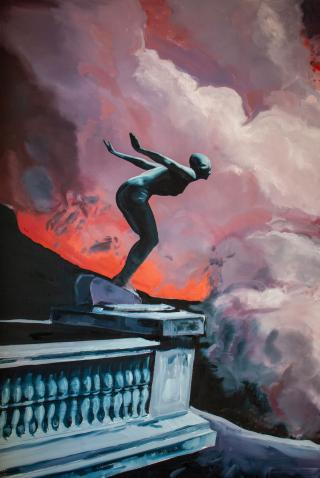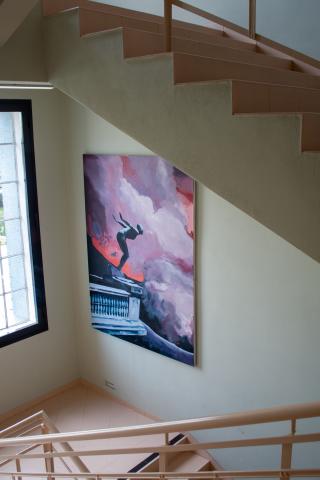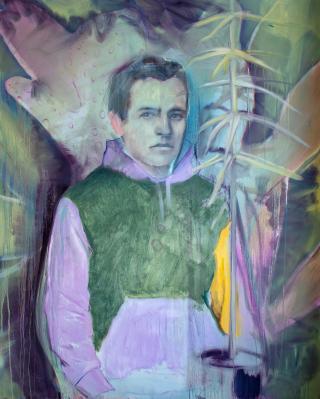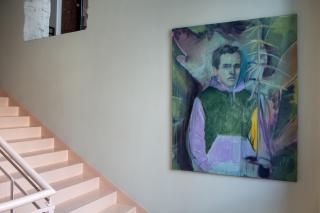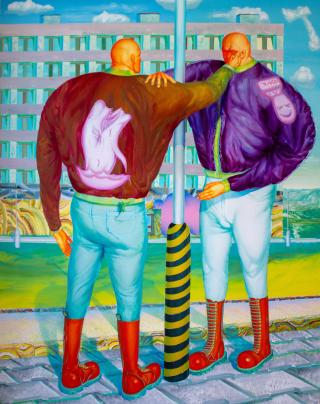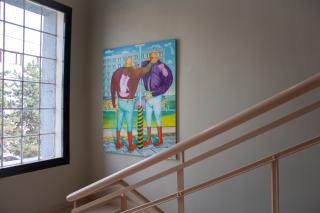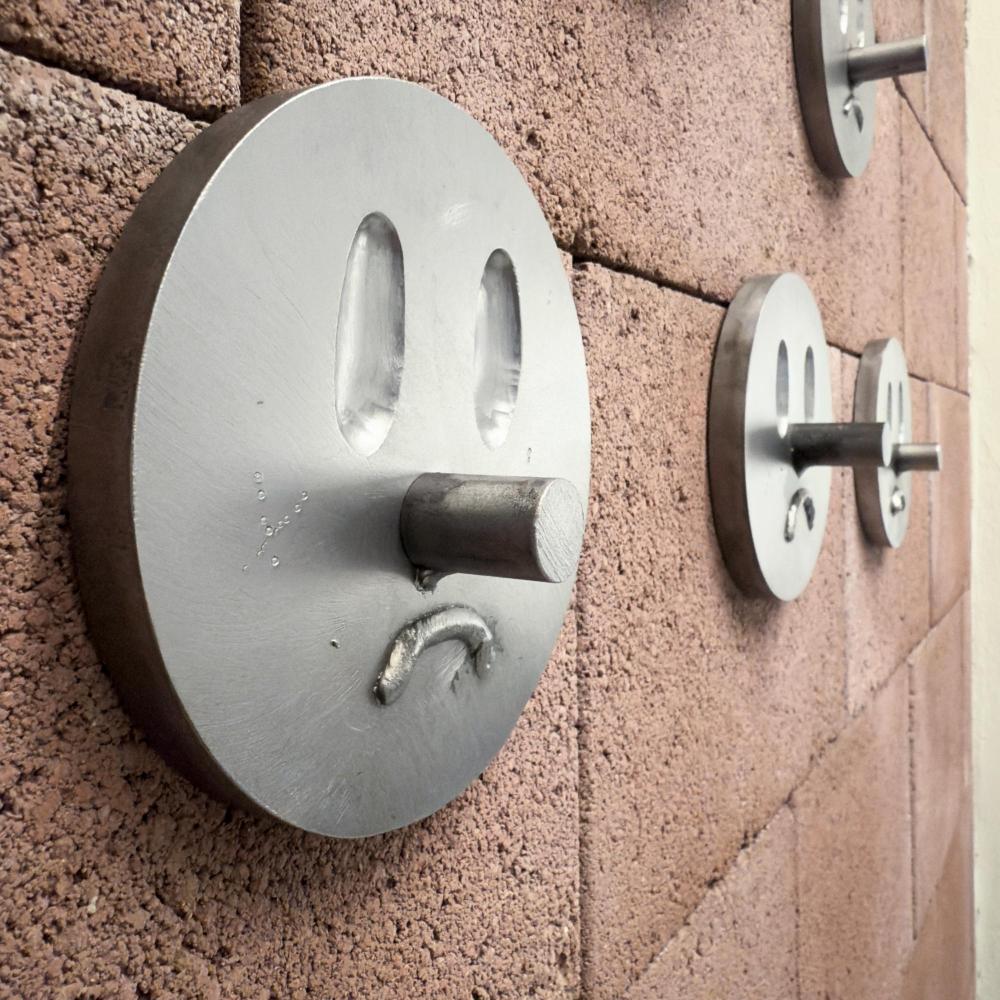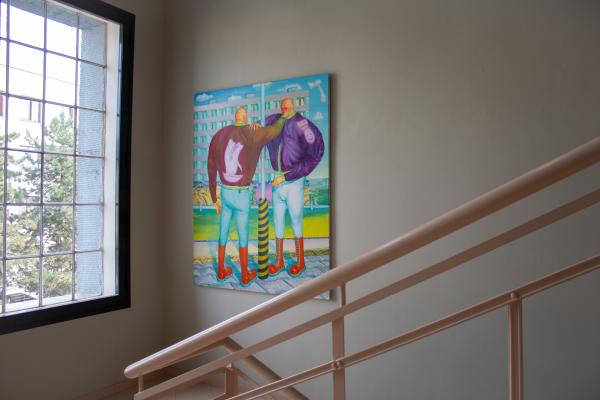
Telegraph Gallery does not offer encounters with visual art only in the main exhibition hall of the gallery or in occasional installations in the cinema hall or loft. If you're a regular visitor to the Telegraph, you may have already noticed the new works that have joined Stefan Belohradsky's existing metal object (Klas, 1974) and enlivened the mezzanine walls. These are large-scale canvases by three young artists, created in the last few years.
First, when ascending the stairs from the first floor, it is an oil painting by Václav Buchtelík entitled Jump (2020). The subject of Buchtelík's paintings is often various forms of anxiety or terror, which can also be represented by the jump into the unknown void depicted here. Nevertheless, the figure gives an uninvolved, almost calm impression that is at odds with the scene evoking uncomfortable anxious feelings. Also typical of Václav Buchtelík is the demonic background, full of clouds of smoke from the erupting volcano. It figuratively depicts a society (in Buchtelík's paintings it is often a socialist society) looking paralysed towards demonic destructive forces.
The counterpart to Buchtelík's world in decay is a static, nameless portrait by Jakub Čuška from 2021 on the opposite wall. The depiction of the young man is entirely subject to the traditional way of depicting the figure in Čuška's paintings. The painter first starts from a photorealistic approach in rendering the face, but then disrupts the narrative and transfers it into a dreamy, blurred, otherworldly representation in which the volume of the human body dissolves into vague shapes. This double grasp also hints at the very nature of the contemporary world - the desire to see down to the very detailed essence of the things and phenomena that surround us, and the subsequent realisation that it is almost impossible to achieve such deep knowledge.
One floor above is the last painting, Cryboy (2022) by Samuel Kollárik. In his controversial paintings, he thematises minority groups of the skinhead movement. Also typical is the very distinctive colouring and distortion of the figures, forming Kollárik's unique and recognisable visual style. The scenes depicted are often full of violence, but also surprising emotional warmth. The same is the case in the painting Cryboy, where two men engage in a strange fist fight from a sufficient distance and through a barrier formed by a street lamp. The picture's message is then somewhat contradictory - elements of the comic or even absurd are mixed with the uncertainty of whether the situation depicted is truly comic or rather a message of the serious.
Read on for a collaborative interview conducted by Michal Vallo.
Monet is only an eye - but my God what an eye.
In the 19th century, Paul Cézanne paid tribute to Claude Monet with this sentence.
What about in the 21st century? Is it about beauty captured in a particular moment? Or about the number of views on a social site profile? Yes, that too is an impression. A 21st century impression. Click - click, tag and embed photos on your profile. On the artist's profile, but who is it? Who is the author of the works? Let's look together at the profile of the three artists exhibiting on the Telegraph's staircase, who share this characteristic: male, mid-thirties, conscious, oriented, normosthenic, medium height, scraggly hair, pupils isochoric, irises with valleys of brown, green and blue, fingers with oil stains, pigments present.
Attributes: tenacity (trait) STAMINA [ˈstæmɪnǝ] n., 1. the ability to persevere in striving to achieve a goal despite the obstacles placed in front of one. Trial-error (method) ERROR [ˈerǝ] n., 1. a method of finding solutions to problems using random testing of all potential outcomes. Happiness (feeling) LUCK [lʌk] n., 1. the comprehensive experience of joy with respect to the fulfillment of hopes, wishes, expectations. 2. the state corresponding to the greatest inner satisfaction with the conditions of one's own being, the understanding of life, and the realization of one's human mission. 3. happiness includes an element of chance.
So gentlemen masters. Can you tell me anything about you that we haven't read or heard before? Well, it won't be that easy. What does your day look like? Do you have a ritual?
V: I come to the studio, have a coffee, have a cigarette and look at the internet. It used to be that I would go and play the drums and the guitar.
J: I avoid rituals because then you have a "commitment" to fulfill. If you don't fulfill it, you have to blame it on something. That happens to me a lot, that I'm not consistent, and then I'd make excuses. So I guess it's a binding, stereotypical thing for me. I come to the studio in the morning. I start painting right away. If I didn't, it would take me a long time to get started. I just sit and look at the paintings or draw. I circle my mistakes.
S: If I don't get to painting right away when I come in, I read, I draw, I smoke a lot. Often I'm just making up verses, oxymorons, sentences, ideas, and visually detaching myself from that. I also follow a selection process. Sometimes I'll just put ideas down on a sketchpad and come back to them in a few months.
Do you paint to music?
V: Yes, I listen to metal, but I'm not an orthodox black metal listener. I also listen to Eminem. But my favourite band is Meshuggah from Sweden. There are also days when I work in complete silence.
J: I listen to music most of the time, but it's not a requirement. When I'm alone in the studio, I play it pretty loud. I like rap, which I see as poetry. I'm generally interested in the words that rap is full of.
S: I almost always listen to music when I paint, but I won't tell you the genre or band. It varies depending on what mood I'm in, I try to hit it with whatever mood the particular day has given me, so it's from ambient, to melancholy, to jazz, to macho rap or post-punk, incorporating techno and a lot of alternative.
Let's get to the very beginning. Did anyone in your family inspire you to become an artist?
V: Not from my family, but the influence of my best friend Eva Konstantinidis. She applied to the secondary art school in Ostrava. She was preparing for the admissions process, so there were still lifes everywhere. Charming. Then I started to go to a preparatory school with the painter Renata Filipová in Petrovice near Karviná. She introduced me to the works of watercolourists such as Otakar Baran, Rudolf Žebrok and Franciszek Świder.
J: In my family, absolutely no one influenced me. The only person in my family who drew illustrations. That was my brother-in-law. My first experience with art was a competition in kindergarten, which I won unplanned. They even printed my picture in the newspaper with a teaser that Jakub Čuška wanted to be a painter one day. I got a kinder egg for it.
S: My father used to draw when he was a kid. He had talent, even though he's a career soldier. He made nice surreal drawings.
Does your family support you?
V: My family goes to exhibition openings. My wife Andrea is a sculptor, so we support each other.
J: The family takes it more seriously now, not like they used to, when they saw it more as a hobby. They go to exhibitions occasionally. I think it's a whole different world for them.
S: They support it, but it wasn't always like that. I should have been a lawyer. Oldest sibling, I was supposed to provide for the family. With my nature, I knew it wasn't going to work out that way. When I applied to high school, I made a deal with my mom that I would go to whichever school I placed better at. The admissions for the arts high school were later because of talent tests, and I was second in high school. She was just banking on not doing better. But at Šup in Kremnica I got an identical position and so we were back to square one. I basically had to tough it out, which makes me wonder today what often makes my leg hurt.
Did you focus on the studio itself when choosing a school? Did you consider studying abroad as well?
V: I followed in the footsteps of my best friend EI to the studio of Professor Daniel Balabán.
J: At the end of high school, I knew that I would definitely not continue as a builder. I was interested in art. When choosing a school, I focused on having the space and time to pursue painting. I wasn't looking for an authority figure to teach me how to paint. I was preparing for the Art School. That's where I met my greatest luck - Adela Janska. She guided me to painting and drawing, thanks to her I know what it really means. I applied to the Faculty of Education at the University of Upper Silesia, majoring in fine arts and German. I studied for 3,5 years, and then I decided to go to the Academy of Fine Arts. I got into the studio of Prof. Martin Mainer and then Prof. Marek Meduna. I was also considering the Vienna Academy, where you don't have to take a German exam until you get your bachelor degree.
S: I went to ŠUP in Kremnica. My love for a girl took me to Ostrava to the Faculty of Arts. Here I studied free graphic arts until my bachelor's degree. As part of that, I managed to do an internship in Krakow. Then we parted ways and I applied to the Academy of Fine Arts in Prague to Prof. Martin Mainer. I thought about continuing abroad, but life in Prague suits me at the moment.
In one of the journals on the Telegraph website we learned about you and the themes of your work. However, I was wondering, given that your work is being shown alongside the New Positions in British Painting exhibition - do you have any relationship to European painting? Are you familiar with the work of British artists?
V: Justin Mortimer is an unquestionable artist and certainly Caroline Walker. Caroline is a consistent, excellent painter with an excellent painterly shorthand, almost Manet-like. Dexter Dalwood is also excellent, taking a collage-like approach to the form. And, lest I forget, Jonathan Wateridge. And from history, the legend Francis Bacon. Next, from the European school - Neo Rauch from Leipzig is a giant for me. I also enjoy the Romanian school from Cluj, such as Adrian Ghenie, Marius Bercea and Radu Baies.
J: European painting is of course a broad term, there is a lot of painting everywhere. I've been through the phenomenon from Britain to Cluj, with the Leipzig school at the forefront. When you say British painting, the icons for me are David Hockney and Lucian Freud. Hockney in particular added colour to my paintings. Caroline Walker is excellent, gestural, bold. There's a kind of mannerism there. Justin Mortimer is a great icon and a bravura painter. You know, different artists, British or Leipzig, inspire me, but because of my inconsistency I don't get to the stage of copying. I realise it's also my salvation. In painting, I like evolution. Again I'm referring to Hockney, who went from intimate crayon drawings to huge paintings, older denser stuff, to light, painted, colourful pictures. I like that. It's important to be going somewhere. If you don't know where, you get inspired elsewhere and you try. The important thing is to be able to leave it. To take only what's your own. You get inspired all the time.
S: Definitely Caroline Walker, with an almost Manet-like manner. She's extremely thoughtful. I like the work of everyone exhibiting, I just love figurative art and the British are undeniably part of it. Lately I can't get enough of Jenny Gribbon's work. You may have asked about Europe but America is culturally related and Jenny's old world tradition is undeniable.
Art and Happiness. How do you feel about that?
V: Happiness to me is some higher power that allows us to move on, clears the sticks under our feet... That power is mutable. I've experienced great happiness in my life, but also great unhappiness, it's relative.
J: Art is my happiness! I believe in things that are behind the curtain of everything. For me, luck is a favourable coincidence. In terms of art, it's definitely an artist's luck if a good gallery finds them and they have a good engagement. It goes hand in hand with the way one works. It doesn't happen by itself. It's definitely not about doing one painting and getting noticed because of it. For me, it's important to do your own thing. Maybe it used to be that "where you've been and who you've met" carried a lot of weight, but I don't think it matters today. Of course, if you're locked up in your studio and you don't use social media, I don't think anyone will see you. If you're comfortable with it, then why not, but it's hard to make a living at it. Unfortunately, you have to expose some of that privacy. For me, for example, Instagram is a living portfolio. You can get closer (to the stars) through platforms like that."
S: Meaning, the honesty of the search, study, happiness, toxic uncertainty, the pursuit of meaning, the search for a way to make life meaningful, even though one is mortal. I see happiness as a discipline in itself and doesn't mean much to me in the short term. Just dopamine, endorphins, comfort and fulfillment of needs. Crises help me to move on and although I sometimes feel like there is no end to one due to my impatience, I see the point in them mirroring different truths of life. So they are part of happiness. In the long run, happiness for me would probably be a certain level of honesty in life as a whole that keeps me from standing still and, despite all the complications, manages to learn, survive and find my place. It would be a specific kind of perseverance producing a belief that in the chain of life in time, every action has its place and meaning.
Life also brings a certain mystique. Has anything happened in your life that would point to paranormal phenomena, drama in the studio or at a show?
V: I had a drama when my painting was stolen - a collage from the Absinthe Forest Club. All that was left was a nail on the wall. There was also a photo of me pointing my finger at the empty space. I mention the fact that I was inspired by a triptych by a well-known artist, so I planted the signal smoke and tornadoes in the painting. At the time, a tornado just passed through Moravia, so I believe I did not summon it.
J: I don't have a ghost story. I have respect for it. Nobody stole anything from me. You know, I guess it's because when you have good paintings, people steal them. If they don't, they don't. I exhibited with Samuel Kollarik, that's how someone wrote in the visitors' book comparing our work. With a positive reference to Samuel, of course.
S: A gallerist was supposed to come to get a painting for the show. I waited for him all afternoon in the studio. He didn't reply my texts. In the morning I found out he had a heart attack right there in the gallery. I've had this painting ever since and I don't want to sell it yet. The painting is mysterious with the figure of a woman, the valerian reds enhance it.
How do you spend your time outside the studio?
V: I play drums in a band called Tilikum. We do instrumentals without vocals, in the direction of noise rock. We played various places in the Czech Republic and Slovakia. Outside of the studio I like to spend time with my wife, with friends, and more recently I play tennis. I also sometimes install various exhibitions, I'm quite a technical type.
J: I'm at home or on the road. Otherwise, I'm in the studio. I don't have many side activities. A friend of mine showed me the magic of the scooter in Athens. I want to buy a small, slow motorcycle and use it as a psychohygiene.
S: I like to run, swim, play basketball. I also go hiking. But I like to go fishing the most, sometimes by myself, sometimes I call my friends. Imagine, you take your fishing rods and go and sit by the Vltava River at night and look at Prague Castle. As you sit there, the river flows, it comes alive mystically, it's very cleansing.
Do you have anything new starting up or what's coming up? Have you thought about a residency as well?
V: After the show with my wife in Vrchlabí, we're taking a little break. Until the end of the year we are planning a group exhibition in Szczecin, Poland. Next year there will be an exhibition in the new city gallery in Karviná. I will also have an exhibition with Jakub Tomáš in Hodonín. I would also like to try a residency. I liked the residency in Leipzig, in the city of contemporary painting.
J: Since September this year I have been a high school professor at the secondary art school in Prostějov. It's a beneficial thing, interacting with people, with students. I like her questions, which you have to know, you answer repeatedly, you think, that way you start to look at the issue differently. For me it's important to convey to them that you can make a living with classical painting. To teach them what it means. In September there was an opening of the group exhibition Anticipation in Ostrava. Next year probably again in Ostrava then in Prague. You know, I like the "in the studio" part. No plans for a residency, but I'd love to be in Italy in a villa with the whole family or in America.
S: Last year I was second in the VUB Foundation's Painting of the Year. Well, since the this year didn't go well, I'm stopping painting. Apparently, I'm going to have an exhibition in Bratislava in November. Another one next year in Prague. I was thinking about a residency, but it's complicated. Mainly economically. You have to keep the rent of the studio, the apartment, then the money for the internship doesn't cover all the costs. But I wouldn't turn down an offer to White Cube in NY. I would also be interested in Leipzig or Berlin.
